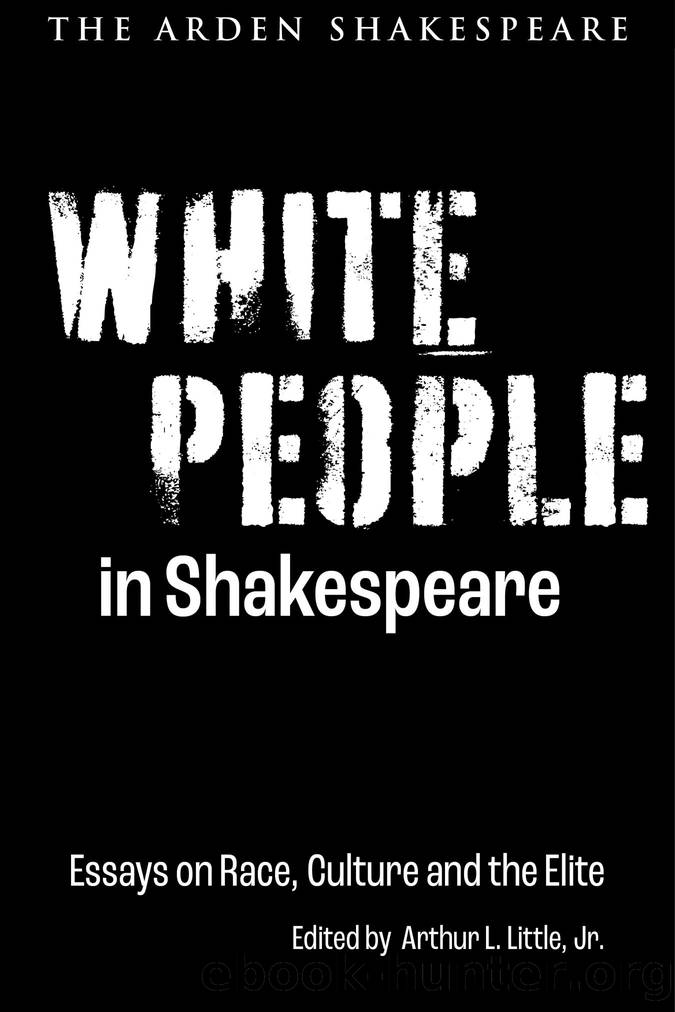White People in Shakespeare by Arthur L. Little Jr

Author:Arthur L. Little, Jr.
Language: eng
Format: epub
ISBN: 9781350283657
Publisher: Bloomsbury Publishing
Published: 2022-10-14T00:00:00+00:00
NOTES
1.I take all Shakespeare quotations from The Arden Shakespeare Complete Works, ed. Richard Proudfoot, Ann Thompson and David Scott Kastan (London: The Arden Shakespeare, 2001), here 1.1.5, and will provide subsequent quotations parenthetically in my text.
2.George Best, A True Discourse of the Late Voyages of Discoverie, for the Finding of a Passage to Cathaya, for the Northweast, Under the Conduct of Martin Frobisher (London, 1584), 29.
3.Ibid., 30.
4.Stating that she was âreally sick of alt-right groups appropriating classical antiquities for nefarious reasonsâ, classicist Sarah Bond wrote a 2017 blog post discussing how much ancient sculpture was originally painted and how the physical whiteness of classical statuary from which in many cases the coloured paint has faded away over time became associated with modern efforts to establish white male bodies as cultural and racial ideals. Bond was inundated with online threats, as described in âFor One Scholar, an Online Stoning Tests the Limits of Public Scholarshipâ, Chronicle of Higher Education, 16 June 2017. See also âWhite Supremacist Propaganda Surges on Campusâ, https://www.adl.org/resources/reports/white-supremacist-propaganda-surges-on-campus.
5.See â âItâs All White Peopleâ: Allegations of White Supremacy are Tearing Apart a Prestigious Medieval Studies Groupâ, Washington Post, 19 September 2019. The article discusses racial tensions in the International Association of Anglo-Saxonists, which came to a head at their 2019 biennial meeting, at which a vote was taken that will change the organizationâs name in recognition of the extent to which âAnglo-Saxonâ has become a âcode for whiteness, a phrase that is co-opted today by white supremacists around the world to advance a false version of white-dominated historyâ.
6.Eclogues, Georgics, Aeneid 1-6, trans. H. Rushton Fairclough, rev. edn G. P. Goold (Cambridge, MA: Harvard University Press, 1999), 369. Iâll provide subsequent citations parenthetically in my text.
7.Here, we can see Shakespeare mixing different kinds of historical materials together as well as following tradition in questioning the absoluteness of Caesarâs success in Britain. See Homer Nearing, Jr., âThe Legend of Julius Caesarâs British Conquestâ, PMLA 64.4 (1949): 889â929.
8.Geoffrey was first translated into English by Aaron Thompson in 1718 and revised by J. A. Giles in 1848. I cite the online edition of Thompson published in the Medieval Latin Series (Cambridge, Ontario: In Parentheses Publications, 1999), 20.
9.Paul Raffield, âCommon Law, Cymbeline, and the Jacobean Aeneidâ, Law and Literature, 27.3 (2015): 313â42, discusses links between the playâs use of legends of national origin and foundation and Jamesâs desire to reform ancient notions of the relationship between the nation and the monarch. Also see Emrys Jones, âStuart Cymbelineâ, Essays in Criticism 11 (1961): 84â99.
10.Both Martin Butlerâs New Cambridge Shakespeare edition of the play (Cambridge: Cambridge University Press, 2005), 3â6, and Roger Warrenâs Oxford Shakespeare edition in Oxford World Classics (Oxford: Oxford University Press, 1998), 63â7, date the play in 1610, placing its concerns with Britishness in line with the mood of such court performances as Jonsonâs and Danielâs masques.
11.P. G. Walsh and M. J. Kennedy, ed. and trans., The History of English Affairs (Warminster, PA: Aris and Phillips Classical Texts, 2008), 29.
12.F. Smith Fussner, The
Download
This site does not store any files on its server. We only index and link to content provided by other sites. Please contact the content providers to delete copyright contents if any and email us, we'll remove relevant links or contents immediately.
| Ancient & Classical | Arthurian Romance |
| Beat Generation | Feminist |
| Gothic & Romantic | LGBT |
| Medieval | Modern |
| Modernism | Postmodernism |
| Renaissance | Shakespeare |
| Surrealism | Victorian |
4 3 2 1: A Novel by Paul Auster(11074)
The handmaid's tale by Margaret Atwood(6874)
Giovanni's Room by James Baldwin(5896)
Big Magic: Creative Living Beyond Fear by Elizabeth Gilbert(4734)
Asking the Right Questions: A Guide to Critical Thinking by M. Neil Browne & Stuart M. Keeley(4599)
On Writing A Memoir of the Craft by Stephen King(4221)
Ego Is the Enemy by Ryan Holiday(4000)
Ken Follett - World without end by Ken Follett(3981)
The Body: A Guide for Occupants by Bill Bryson(3815)
Bluets by Maggie Nelson(3722)
Adulting by Kelly Williams Brown(3681)
Guilty Pleasures by Laurell K Hamilton(3600)
Eat That Frog! by Brian Tracy(3525)
White Noise - A Novel by Don DeLillo(3443)
The Poetry of Pablo Neruda by Pablo Neruda(3371)
Alive: The Story of the Andes Survivors by Piers Paul Read(3320)
The Bookshop by Penelope Fitzgerald(3237)
The Book of Joy by Dalai Lama(3234)
Fingerprints of the Gods by Graham Hancock(3222)
